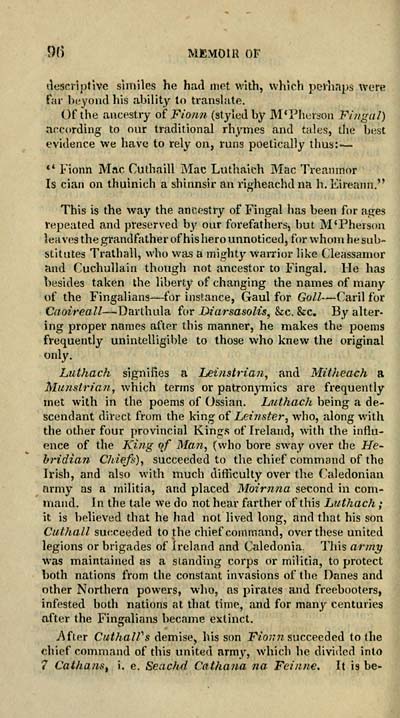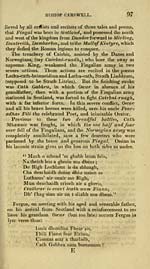Download files
Complete book:
Individual page:
Thumbnail gallery: Grid view | List view

9() MBMOIH OF
tìescriptìve sìmiles he had iTiet with, whìch peihaijs were
Far l)eyond his ability lo transhite.
()f the ancestry oi Fiorm (styledby M'Phersoii Fingal)
arcording to our traditional rhymes and tales, the best
evidence vve have to rely on, runs poetically thus: —
** Fionn Mac Cuthaill Mac Luthaich Mac Treanmor
Is cian on thuinich a shinnsìr an righeachdna h.Eireann."
This is the way the ancestry of Fìngal lias been for ages
repeated and preserved by our forefathers, ì)Ut M'Phersou
leaves the grandfather of his hero unnoticed, for whom he sub-
stitutes Trathall, who was a mighty warrior like Cleassamor
and Cuchullain though not ancestor to Fingal. Fle has
hesides taken the Uberty of changing the names of many
of the Fingalians— for insiance, Gaul for Goll — Caril for
CrtotreaZ/— Darthula for Diarsasolis^ &c. &c. By alter-
ing proper names afler this manner, he makes the poems
frequentiy unintelligible to those who knew the original
only.
Luthach signifies a Leinstrian, and Mitheach a
Munstrian, which terms or patronymics are frequently
met with in the poems of Ossian. Lnthach being a de-
scendant direct from the king oi Leinster, who, along with
the other four provincial Kinjjs of Ireland, with the influ-
ence of the King f{f Ma?i, (who bore sway over the He-
bridian Chìefs), succeeded to the chief command of the
Irish, and also with much difficuhy over the Caledonian
nrmy as a miHtia, and placed Moirnna second in com-
mand. In the tale we do not hear farther of this Luthach ;
it is behevtìd that he had not lived long, and that his son
Cuthall succeeded to the chief conimand, overthese united
legions or brigades of Ireland and Caledonia, This arrny
was maintained as a standing corps or militia, to protect
both nations from the constant invasions of tbe Dnnes and
other Northern powers, wlio, ns pirates and freebooters,
infested both nations at that timc, and for many centuries
after the Fingalians became extinct.
7\ftpr CuthalVs demise, his son Peo;rw succeedcd to the
chief command of this united army, which he divided into
7 Cathans, i. e. Scacfid Cathana na Feinne. It is be-
tìescriptìve sìmiles he had iTiet with, whìch peihaijs were
Far l)eyond his ability lo transhite.
()f the ancestry oi Fiorm (styledby M'Phersoii Fingal)
arcording to our traditional rhymes and tales, the best
evidence vve have to rely on, runs poetically thus: —
** Fionn Mac Cuthaill Mac Luthaich Mac Treanmor
Is cian on thuinich a shinnsìr an righeachdna h.Eireann."
This is the way the ancestry of Fìngal lias been for ages
repeated and preserved by our forefathers, ì)Ut M'Phersou
leaves the grandfather of his hero unnoticed, for whom he sub-
stitutes Trathall, who was a mighty warrior like Cleassamor
and Cuchullain though not ancestor to Fingal. Fle has
hesides taken the Uberty of changing the names of many
of the Fingalians— for insiance, Gaul for Goll — Caril for
CrtotreaZ/— Darthula for Diarsasolis^ &c. &c. By alter-
ing proper names afler this manner, he makes the poems
frequentiy unintelligible to those who knew the original
only.
Luthach signifies a Leinstrian, and Mitheach a
Munstrian, which terms or patronymics are frequently
met with in the poems of Ossian. Lnthach being a de-
scendant direct from the king oi Leinster, who, along with
the other four provincial Kinjjs of Ireland, with the influ-
ence of the King f{f Ma?i, (who bore sway over the He-
bridian Chìefs), succeeded to the chief command of the
Irish, and also with much difficuhy over the Caledonian
nrmy as a miHtia, and placed Moirnna second in com-
mand. In the tale we do not hear farther of this Luthach ;
it is behevtìd that he had not lived long, and that his son
Cuthall succeeded to the chief conimand, overthese united
legions or brigades of Ireland and Caledonia, This arrny
was maintained as a standing corps or militia, to protect
both nations from the constant invasions of tbe Dnnes and
other Northern powers, wlio, ns pirates and freebooters,
infested both nations at that timc, and for many centuries
after the Fingalians became extinct.
7\ftpr CuthalVs demise, his son Peo;rw succeedcd to the
chief command of this united army, which he divided into
7 Cathans, i. e. Scacfid Cathana na Feinne. It is be-
Set display mode to: Large image | Transcription
Images and transcriptions on this page, including medium image downloads, may be used under the Creative Commons Attribution 4.0 International Licence unless otherwise stated. ![]()
| Early Gaelic Book Collections > Hew Morrison Collection > Laoidheadair Gaelic na òrain spioradail > (122) |
|---|
| Permanent URL | https://digital.nls.uk/79981842 |
|---|
| Description | A selection of items from a collection of 320 volumes and 30 pamphlets of literary and religious works in Scottish Gaelic. From the personal library of Hew Morrison, the first City Librarian of Edinburgh. |
|---|
| Description | Selected items from five 'Special and Named Printed Collections'. Includes books in Gaelic and other Celtic languages, works about the Gaels, their languages, literature, culture and history. |
|---|

